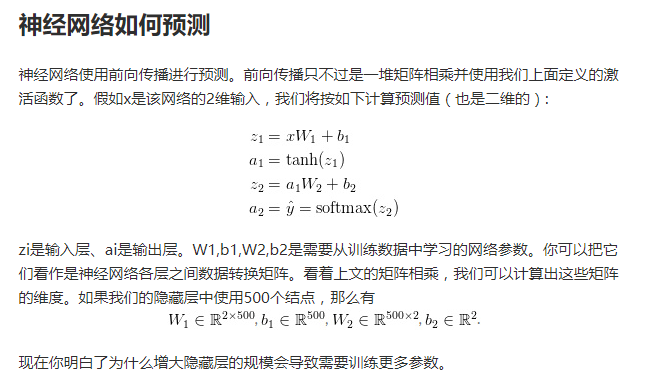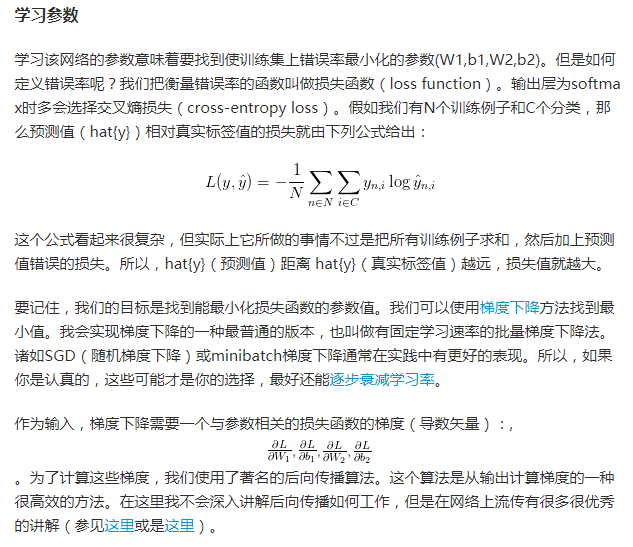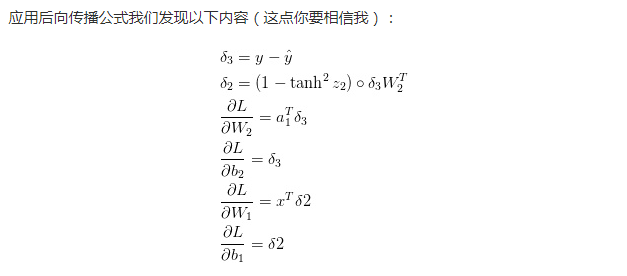使用Jupter Notebook实现简单的神经网络
参考:http://python.jobbole.com/82208/
注:1)# %matplotlib inline 注解可以使Jupyter中显示图片
2)注意包的导入方式
一、使用的Python包
1)numpy
numpy(Numerical Python)提供了python对多维数组对象的支持:ndarray,具有矢量运算能力,快速、节省空间。numpy支持高级大量的维度数组与矩阵运算,此外也针对数组运算提供大量的数学函数库。
参考:http://blog.csdn.net/cxmscb/article/details/54583415
2)sklearn
机器学习的一个实用工具,提供了数据集,数据预处理,常用的数据模型等
参考:https://www.cnblogs.com/lianyingteng/p/7811126.html
3)matplotlib
matplotlib在Python中应用最多的2D图像的绘图工具包,使用matplotlib能够非常简单的可视化数据。
参考:http://blog.csdn.net/claroja/article/details/70173026
二、神经网络学习原理



神经网络反射推到
https://www.cnblogs.com/biaoyu/archive/2015/06/20/4591304.html
交叉熵损失函数
http://blog.csdn.net/jasonzzj/article/details/52017438
三、实现思路
四、代码
# %matplotlib inline #add for display picture
import numpy as np
from sklearn import datasets
from matplotlib import pyplot as plt
# Generate a dataset and plot it
np.random.seed(0)
X, y = datasets.make_moons(200, noise=0.20)
plt.scatter(X[:,0], X[:,1], s=40, c=y, cmap=plt.cm.Spectral)
plt.show
Out[24]:
<function matplotlib.pyplot.show> In [19]:
def plot_decision_boundary(pred_func):
# Set min and max values and give it some padding
x_min, x_max = X[:, 0].min() - .5, X[:, 0].max() + .5
y_min, y_max = X[:, 1].min() - .5, X[:, 1].max() + .5
h = 0.01
# Generate a grid of points with distance h between them
xx, yy = np.meshgrid(np.arange(x_min, x_max, h), np.arange(y_min, y_max, h))
# Predict the function value for the whole gid
Z = pred_func(np.c_[xx.ravel(), yy.ravel()])
Z = Z.reshape(xx.shape)
# Plot the contour and training examples
plt.contourf(xx, yy, Z, cmap=plt.cm.Spectral)
plt.scatter(X[:, 0], X[:, 1], c=y, cmap=plt.cm.Spectral)
In [20]:
from sklearn import linear_model
# Train the logistic rgeression classifier
clf = linear_model.LogisticRegressionCV()
clf.fit(X, y) # Plot the decision boundary
plot_decision_boundary(lambda x: clf.predict(x))
plt.title("Logistic Regression")
Out[20]:
<matplotlib.text.Text at 0x1d21f527f98> In [14]:
# Helper function to evaluate the total loss on the dataset
def calculate_loss(model):
W1, b1, W2, b2 = model['W1'], model['b1'], model['W2'], model['b2']
# Forward propagation to calculate our predictions
z1 = X.dot(W1) + b1
a1 = np.tanh(z1)
z2 = a1.dot(W2) + b2
exp_scores = np.exp(z2)
probs = exp_scores / np.sum(exp_scores, axis=1, keepdims=True)
# Calculating the loss
corect_logprobs = -np.log(probs[range(num_examples), y])
data_loss = np.sum(corect_logprobs)
# Add regulatization term to loss (optional)
data_loss += reg_lambda/2 * (np.sum(np.square(W1)) + np.sum(np.square(W2)))
return 1./num_examples * data_loss
In [15]:
# Helper function to predict an output (0 or 1)
def predict(model, x):
W1, b1, W2, b2 = model['W1'], model['b1'], model['W2'], model['b2']
# Forward propagation
z1 = x.dot(W1) + b1
a1 = np.tanh(z1)
z2 = a1.dot(W2) + b2
exp_scores = np.exp(z2)
probs = exp_scores / np.sum(exp_scores, axis=1, keepdims=True)
return np.argmax(probs, axis=1)
In [22]:
# This function learns parameters for the neural network and returns the model.
# - nn_hdim: Number of nodes in the hidden layer
# - num_passes: Number of passes through the training data for gradient descent
# - print_loss: If True, print the loss every 1000 iterations
def build_model(nn_hdim, num_passes=20000, print_loss=False): # Initialize the parameters to random values. We need to learn these.
np.random.seed(0)
W1 = np.random.randn(nn_input_dim, nn_hdim) / np.sqrt(nn_input_dim)
b1 = np.zeros((1, nn_hdim))
W2 = np.random.randn(nn_hdim, nn_output_dim) / np.sqrt(nn_hdim)
b2 = np.zeros((1, nn_output_dim)) # This is what we return at the end
model = {} # Gradient descent. For each batch...
for i in range(0, num_passes): # Forward propagation
z1 = X.dot(W1) + b1
a1 = np.tanh(z1)
z2 = a1.dot(W2) + b2
exp_scores = np.exp(z2)
probs = exp_scores / np.sum(exp_scores, axis=1, keepdims=True) # Backpropagation
delta3 = probs
delta3[range(num_examples), y] -= 1
dW2 = (a1.T).dot(delta3)
db2 = np.sum(delta3, axis=0, keepdims=True)
delta2 = delta3.dot(W2.T) * (1 - np.power(a1, 2))
dW1 = np.dot(X.T, delta2)
db1 = np.sum(delta2, axis=0) # Add regularization terms (b1 and b2 don't have regularization terms)
dW2 += reg_lambda * W2
dW1 += reg_lambda * W1 # Gradient descent parameter update
W1 += -epsilon * dW1
b1 += -epsilon * db1
W2 += -epsilon * dW2
b2 += -epsilon * db2 # Assign new parameters to the model
model = { 'W1': W1, 'b1': b1, 'W2': W2, 'b2': b2} # Optionally print the loss.
# This is expensive because it uses the whole dataset, so we don't want to do it too often.
if print_loss and i % 1000 == 0:
print ("Loss after iteration %i: %f" %(i, calculate_loss(model))) return model
In [17]:
num_examples = len(X) # training set size
nn_input_dim = 2 # input layer dimensionality
nn_output_dim = 2 # output layer dimensionality # Gradient descent parameters (I picked these by hand)
epsilon = 0.01 # learning rate for gradient descent
reg_lambda = 0.01 # regularization strength
In [23]:
# Build a model with a 3-dimensional hidden layer
model = build_model(3, print_loss=True) # Plot the decision boundary
plot_decision_boundary(lambda x: predict(model, x))
plt.title("Decision Boundary for hidden layer size 3")
Loss after iteration 0: 0.432387
Loss after iteration 1000: 0.068947
Loss after iteration 2000: 0.068890
Loss after iteration 3000: 0.071218
Loss after iteration 4000: 0.071253
Loss after iteration 5000: 0.071278
Loss after iteration 6000: 0.071293
Loss after iteration 7000: 0.071303
Loss after iteration 8000: 0.071308
Loss after iteration 9000: 0.071312
Loss after iteration 10000: 0.071314
Loss after iteration 11000: 0.071315
Loss after iteration 12000: 0.071315
Loss after iteration 13000: 0.071316
Loss after iteration 14000: 0.071316
Loss after iteration 15000: 0.071316
Loss after iteration 16000: 0.071316
Loss after iteration 17000: 0.071316
Loss after iteration 18000: 0.071316
Loss after iteration 19000: 0.071316
Out[23]:
<matplotlib.text.Text at 0x1d21f1fd8d0> In [ ]:
使用Jupter Notebook实现简单的神经网络的更多相关文章
- tensorflow笔记(二)之构造一个简单的神经网络
tensorflow笔记(二)之构造一个简单的神经网络 版权声明:本文为博主原创文章,转载请指明转载地址 http://www.cnblogs.com/fydeblog/p/7425200.html ...
- L1-L11 jupter notebook 文件
L1-L11 jupter notebook 文件下载地址 https://download.csdn.net/download/xiuyu1860/12157961 包括L12 Transforme ...
- tensorflow学习笔记四:mnist实例--用简单的神经网络来训练和测试
刚开始学习tf时,我们从简单的地方开始.卷积神经网络(CNN)是由简单的神经网络(NN)发展而来的,因此,我们的第一个例子,就从神经网络开始. 神经网络没有卷积功能,只有简单的三层:输入层,隐藏层和输 ...
- TensorFlow入门,基本介绍,基本概念,计算图,pip安装,helloworld示例,实现简单的神经网络
TensorFlow入门,基本介绍,基本概念,计算图,pip安装,helloworld示例,实现简单的神经网络
- C++从零实现简单深度神经网络(基于OpenCV)
代码地址如下:http://www.demodashi.com/demo/11138.html 一.准备工作 需要准备什么环境 需要安装有Visual Studio并且配置了OpenCV.能够使用Op ...
- 用pytorch1.0快速搭建简单的神经网络
用pytorch1.0搭建简单的神经网络 import torch import torch.nn.functional as F # 包含激励函数 # 建立神经网络 # 先定义所有的层属性(__in ...
- 用pytorch1.0搭建简单的神经网络:进行多分类分析
用pytorch1.0搭建简单的神经网络:进行多分类分析 import torch import torch.nn.functional as F # 包含激励函数 import matplotlib ...
- 用pytorch1.0搭建简单的神经网络:进行回归分析
搭建简单的神经网络:进行回归分析 import torch import torch.nn.functional as F # 包含激励函数 import matplotlib.pyplot as p ...
- Jupter Notebook常用快捷键与常用的魔法命令
jupter notebook快捷键整理 Part1 1.删除Cell——双击D 2.撤销删除——Z 3.新建Cell——A/B (向上/向下) 4.命令窗口——P 5.运行——Ctrl+Enter ...
随机推荐
- Ubuntu 16.04下使用gcc输出汇编的.0文件为可执行文件时出现:`_start'被多次定义
错误如下: `_start'被多次定义 /usr/lib/gcc/x86_64-linux-gnu/5/../../../x86_64-linux-gnu/crt1.o:(.text+0x0):第一次 ...
- DICOM:dcm4che工具包怎样压缩dcm文件探讨(续篇)
背景 前段时间博文DICOM:dcm4che工具包怎样压缩dcm文件探讨(前篇)提到了一个问题:"利用dcm4che工具包中的dcm2dcm来进行dcm文件的压缩和加压缩.即改变dcm文件里 ...
- POJ 2485 Highways && HDU1102(20/200)
题目链接:Highways 没看题,看了输入输出.就有种似曾相识的感觉,果然和HDU1102 题相似度99%,可是也遇到一坑 cin输入居然TLE,cin的缓存不至于这么狠吧,题目非常水.矩阵已经告诉 ...
- python hehe
键盘监听事件 标签: 键盘监听python 2016-08-22 14:36 226人阅读 评论(0) 收藏 举报 分类: 其他(33) 本文以一段简单的监听鼠标.键盘事件的程序,实现获取用户的输 ...
- Eclipse导入外部项目问题总结
此次在项目开发过程中导入从oksvn下载的共享项目时出现几个项目在不同的IDE导入导出时的问题,为免忘记做例如以下笔记: 1 类路径问题 在Java开发中大多数的开发人员使用的IDE是MyEcl ...
- Unity学习笔记(4) --- Unity的界面排版:初识GUI
GUI和GUILayout是Unity提供的UIKit.在使用GUI的Controls时都要求设置Rect參数.没办法做到自己主动排版,给适配带来难度.而GUILayout的设计就是为了弥补这个缺陷, ...
- 树莓派玩耍笔记1 -- 开箱 & 安装系统以及简单配置
零.前言 树莓派是什么? 吃的么? 呵呵,假设您连这个还不知道,真是out 了. 麻烦出门左拐.百度去(或者,看看官网去?),算了.还是粘贴一些大家都知道的树莓派百科吧: 树莓派由注冊于英国的慈善组织 ...
- expect安装测试-批量用户管理
安装: yum list | grep expect yum install expect 批量创建用户: ansible mysqldb -m user -a 'name=ansible state ...
- Combining an audio file with video file in python
Combining an audio file with video file in python - Stack Overflow https://stackoverflow.com/questio ...
- MarkMonitor 目前最安全的域名注册商,因此,世界500强网站中的22%域名托管于markmonitor公司
也许你查询某个大型公司域名whios信息时,常常会发现很多这些大型公司的域名都在一家名为MarkMonitor的公司注册,那么markmonitor是家什么样的公司呢? MarkMonitor是一家从 ...
